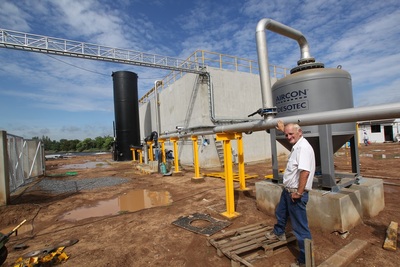How sweet it is: cane processors profit with green energy and environmental benefits
Tuesday, 03 September, 2013
A global leader in the production of green energy from food and agribusiness wastewater is deploying advanced anaerobic technologies that achieve high returns of biogas from the world’s largest crop - sugar cane.
The crop - which is grown in more than 90 countries with a worldwide harvest exceeding 1.6 billion tonnes - has historically not been suited to biogas production because the vast amounts of water used in its processing were too weak in their organic carbon concentration to yield profitable amounts of methane.
However, Global Water Engineering says the industry has progressively used less water in recent years, increasing its waste stream concentrations to levels where it can be very successfully exploited for biogas and produce less effluent pollution through the latest anaerobic technologies.
“Use of less water can produce major environmental benefits in the cane industry, where the size of a processing plant bears little relation to the huge amount of wastewater it has traditionally produced,” says GWE President and CEO Mr Jean Pierre Ombregt. “We are now getting towards the stage where, instead of having a series of huge anaerobic and aerobic lagoons impacting the environment, we can treat the effluent in contained anaerobic reactors where biogas is extracted and influent wastewater is cleaned of most of its impurities without release to the environment.”
One of the latest cane sugar mills to use GWE anaerobic technology incorporating its ANUBIX B reactor is the United Farmer and Industry cane sugar mill at Khon Kaen in Thailand, a country which is one of the world’s largest cane sugar producers, along with Brazil, India, China, Pakistan and Mexico. Australia is the third-largest raw sugar supplier in the world, with 4000 cane farm businesses producing 4-4.5 Mt of raw sugar, worth $1.7-2.0 billion, through 24 sugar mills.
The plant commissioned at Khon Kaen this year has a capacity of 3500 m3 a day of wastewater containing 22,750 kg a day COD (chemical oxygen demand) of natural origin that can be broken down into biogas by anaerobic bacteria. The process employed at United Farmer and Industry comprised an influent screen, equalisation, pH control, anaerobic treatment, biogas flare and two-stage biogas sweetening.

Biogas production is currently building to 9000 Nm3 a day (75% CH4), which will be used as fuel in several factory steam boilers.
Wastewater effluent levels have also benefited substantially, with a minimum of 85% removal of COD being achieved (to a maximum 975 mg/L COD, produced from influent with 6500 mg/L COD, or 3250 mg/L BOD (biochemical oxygen demand).
GWE’s ANUBIX B medium-to-high loading rate UASB (upflow anaerobic sludge bed) reactor employed at the plant is of a type used for most low- to medium-strength mainly soluble carbohydrate containing effluents. The effluent COD reduction achieved at United Farmer and Industry is outstanding by cane industry standards, while in broader food and beverage industry service such technology has attained very high COD removal efficiencies, in some cases up to 99%.
“In addition to substantial environmental benefit from cleaner water being treated in reactor tanks rather than lagoons, the United Farmers Plant achieves a supply of green energy that delivers energy savings virtually in perpetuity,” says Ombregt.
Existing GWE anaerobic technologies of the type employed at United Farmer and Industry typically produce enough green energy to pay for the cost of their installation in typically one or two years.
In addition, the reactors reduce the need for huge lagoons with their associated odour, land use and environmental leaching issues. Such issues are strongly relevant to the use of such technology in Australia, says the managing director of CST Wastewater Solutions, Michael Bambridge.
Energy savings alone can amount to millions of dollars a year. For example, Corn Products - a major producer of native tapioca starch, sweeteners and modified starch - uses GWE anaerobic technology within one of its wastewater plants in Thailand to produce up to 70,000 Nm3 a day of biogas at 70% CH4. This corresponds with approximately 43,750 kg a day of heavy fuel oil, worth US$12.7 million a year. (This assumes a plant running 330 days a year at full capacity and a heavy fuel oil, HFO, price of US0.83c a litre.)
The advanced anaerobic technology such as that installed at United Farmers and Industry is strongly applicable to any factory or process with one or more digestible solid waste streams. Such plants - including breweries, fruit, food waste, agro industries, and energy crops including corn and cane used for ethanol - can easily use this technology to generate energy. It opens the door to environmental and production efficiency gains globally, says GWE.
Climate-friendly electricity from ammonia
Researchers the Fraunhofer Institute have developed a high-temperature fuel cell stack that can...
Digitalised, sustainable battery cell production
German researchers have developed a flexible winding system for battery cells that is embedded in...
Expired deadline threatens critical infrastructure as compliance lags
The deadline for achieving cybersecurity framework alignment for the SOCI Act expired on 17...












